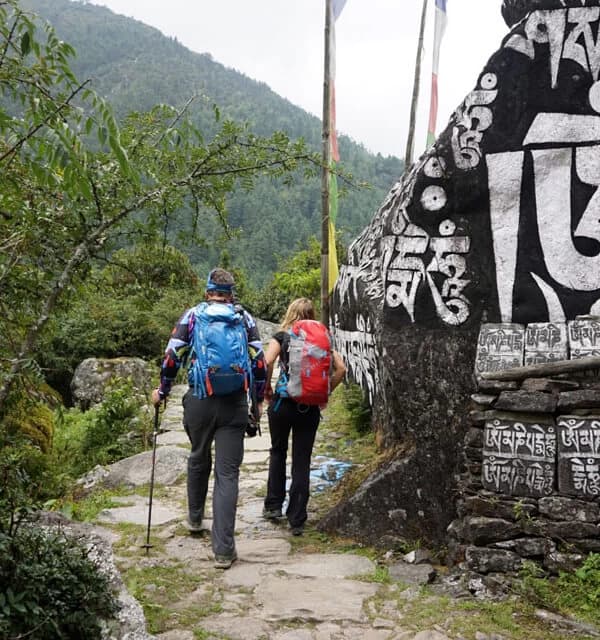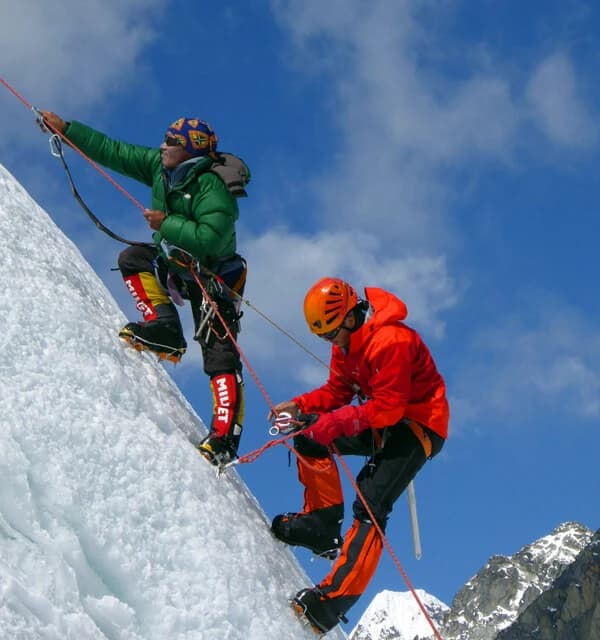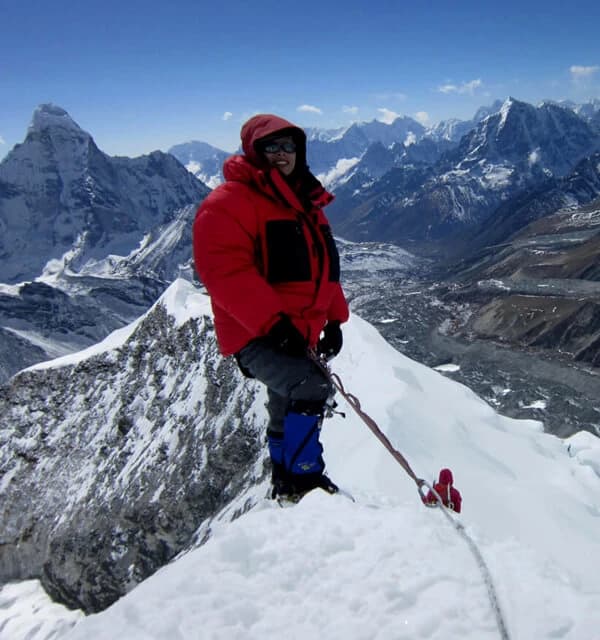Mera Peak Climbing Overview
Climbing the Mera Peak, a thrilling, scenically stunning, and exciting venture, is terrifically popular among adventure trekking and climbing lovers. Mera Peak (6461 meters high) is one of the fascinating trekking peaks in the Everest region of Nepal, as it involves a culturally stimulating journey through remote, picturesque villages and forests, followed by a gentle climb to the summit. It is perhaps best known because it is Nepal’s highest trekking peak. Mera Peak Situated on the edge of the famous Khumbu Region and dominated by Mt. Everest, the Mera Peak Expedition is an opportunity for all physically fit adventure seekers. Lifting the eyes from Mera and keep on lifting them until, above the clouds, its summit panorama takes in five of the world's eight-thousand-meter peak Mountains; Everest, Kanchenjunga, Makalu, Lhotse, Cho-Oyu, and many other peaks are an unforgettable experience.
Mera Peak Expedition starts in Kathmandu, where we make preparations and enjoy the diversity of this ancient town before boarding our exciting mountain flight into the town of Lukla in the Khumbu Valley. With a short and exciting flight to Lukla, which also provides the start point of the Standard Everest Base Camp Trek, after a continuous trek for days through the high and lovely valleys, you will get to the area of Mera. Although physically very challenging on account of the altitude, the climb on Mera Peak is not technically difficult, as ascending snow slopes rarely exceed 40 degrees. The only requirement you should have to ascend Mera Peak is your excellent physical fitness and an extroverted sense of adventure. Our sensibly designed Mera Peak Climbing itinerary has been designed to allow gradual acclimatization for the climbers. The walk initially through the virgin forest of the Hinku Valley is extraordinarily beautiful and provides excellent acclimatization for the peak itself. Our unrivaled service, quality equipment, food, trekking staff, and experienced leader ensure that your Mera Peak Expedition will be a lifetime adventure experience in Nepal.
How much does it cost to climb Mera Peak?
Mera Peak Climbing package cost depends on the group size, season, and the mode of trip. We have updated the trip cost to USD 1799 per person, based on two or more people for the year 2026. And this is the standard trek Mera Peak Climbing expedition price. A single supplement will cost an extra USD 300.00. The package cost does not include accommodation in Kathmandu; we can handle your accommodation booking if you ask us at an extra cost.
How hard is climbing and Summiting Mera Peak?
Climbing the Mera Peak is not for the faint-hearted, but an easy peak-climbing expedition for well-experienced trekkers and climbers. This means that the technical requirement is very basic and includes the use of ropes, ice axes, and crampons. You are also required to have good cardiovascular fitness. Mera Peak is not categorized as a technical peak, but a bit of technical knowledge would be helpful for a small section of the climb, which is about 50m. This will probably be the toughest part of the climb, as the slope is around 40 degrees of ice/snow. Previous experience with using ice axes and crampons is preferred, although not mandatory, because basic ice-climbing training will be provided before the summit. Lots of willpower, the ability to tolerate harsh conditions, reasonable fitness, and good health will help in making this trip successful. Participants with pre-existing medical problems or conditions must be informed about the Wilderness Excursion at the time of booking.
How is the accommodation along the route to Base Camp Mera Peak?
Your accommodation will be in trekking lodges and teahouses during the entire trek route, and tents will be provided during the expedition, which is within the trip cost. Most of the teahouse accommodations will only have shared toilet facilities. For tent accommodations, a 4-season sleeping bag and foam mattress will be provided. In the climbing section, toilet facilities will be provided with necessary natural preservation. All accommodations in the teahouses are on a twin-shared basis, whereas a single tent will be provided to each individual for the climbing section if required. We are happy to reserve the accommodation in Kathmandu if you want us to include it pre- and post-Mera Peak Climbing. In the trekking route to Mera Base Camp, several teahouses do not allow single-room accommodation, but sometimes it is feasible only in the trekking areas of the lower elevation.
How is the meal during the trip of Mera Peak Climbing trip?
There will be a buffet breakfast in Kathmandu, and on our Mera Peak climbing trip, we can enjoy Nepalese, Tibetan, Indian, and the more common continental cuisines. All meals, including breakfast, lunch, and dinner, will be available during the trekking and climbing sections. A farewell dinner is also included in the package. Farewell dinner will be in one of the authentic Nepalese restaurants with live cultural dance.
Our Mera Peak expedition team
Guide: The most significant thing that makes your Mera Peak Climbing trip successful, enjoyable, and memorable is the skilled, experienced, courteous, and helpful trek and climb leader and the crew members who can operate your days in the mountain smoothly. Your trip will be led by the best and most professional leaders. All of our trekking/climbing leaders are carefully selected based on their appropriate experience, leadership skills, and personal aptitude. To sustain local communities, Wilderness Excursion employs Nepalese staff members who have proficient knowledge of the culture, ecosystem, flora, fauna, geography, and history of Nepal. Trek/climb leaders of WE are also trained with the following training to educate them on potential medical issues during their trek, biodiversity and environmental issues, English language, etc.
Porter Care: We believe that hard-working local porters are the backbone of the entire trekking and expedition industry in Nepal. It is their tireless efforts carrying supplies, equipment, and baggage that make journeying to these isolated areas possible. So it's very unfortunate that they have endured a history of exploitation and abuse at the hands of the industry. To combat this, we are firmly committed to porter rights. We ensure all our porters are well-treated and well-paid, and we provide the level of shelter, clothing, and footwear that these harsh environments demand. Porters who become sick are treated with the same care and attention as other team members, and we have previously used helicopters—at our expense—to rescue porters from dangerous situations. We support the work of the International Porter Protection Group (IPPG), making our resources available to them to help improve the working conditions of the porters. (International Porters Progress Group)
Responsible Tourism Practice / Green Tourism Policy
Nepal is gorgeously beautiful but similarly fragile. Future generations have just as much of a right to appreciate it as we do. So, the tourism industry commits to protecting and preserving it. We employ a 'zero impact' policy on the natural environment.
Do I need travel insurance for this expedition?
We highly recommend that its clients join any adventure activities by bringing travel insurance that must provide and cover personal accident, medical expenses, emergency rescue services, and personal liability. It is a condition upon joining any of Wilderness Excursion’s trips that all clients be insured for comprehensive expenses that might be incurred due to medical issues or accidents (this includes helicopter rescue and treatment costs). Please note that we don't arrange or sell insurance.
Is an acclimatization day required before heading to the Mera Peak Summit?
Acclimatization is a particularly important medical consideration while trekking and climbing the high Himalayas of Nepal to high altitudes to prevent high-altitude sickness known as AMS (Acute Mountain Sickness), which can be lethal if one is not careful. Mild symptoms of AMS are headaches, fever, loss of appetite, or stomach disorders. For a safe trekking and climbing experience, it is extremely essential to allow sufficient time for acclimatization. The itinerary for Mera Peak Climbing moves onward at a gentle pace so as to allow plenty of time for acclimatization.
When is the best time for Climbing Mera Peak?
The best time to climb Mera Peak is spring (March to May) and autumn (September to November). The best months have been defined based on visibility and weather conditions. Climbing in winter is less popular as cold temperatures can be harsh and the lodges on the way close during the off-season. Anyone willing to climb in the winter should arrange a fully supported camping trek; however, a climbing permit is cheap in the winter, costing USD 70.00 per person, and the garbage deposit is still USD 500.00 for the whole group.
Are there different routes to Mera Peak Base Camp? Which route should I take?
There are three trekking routes to Khare, which is the BASE of the Mera Peak Expedition; the routes are:
1. Short route: Fly to Lukla and walk straight to Khare via Zwatra La-Khare. Suggested for experts and short timers.
2. Fly in Lukla, walk south to Surke, and trek through Hinku/Honku Valley, then trek to Kothe-Khare, which is the best considering acclimatization.
3. The third option is to take a private/local jeep to Salleri or fly to Phaplu, and join the Classic Jiri Everest Base Camp Trekking trail – Puiyan to Hinko Valley to Khare






